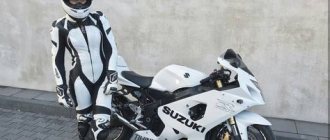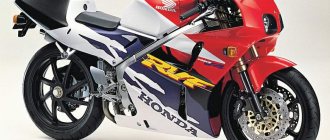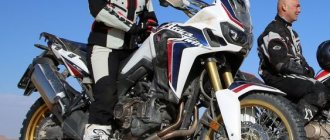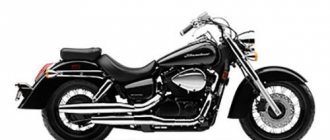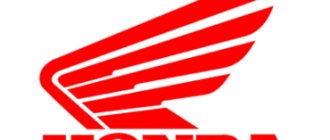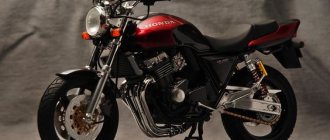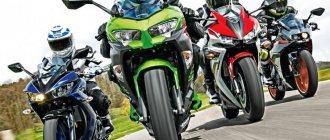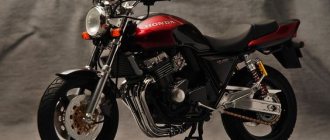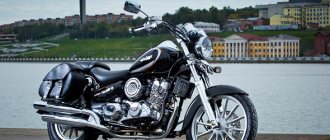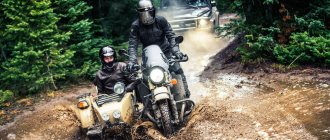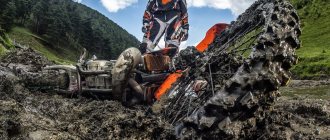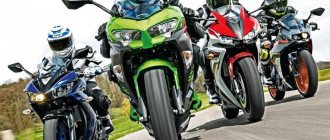It's no secret that naked bikes have long won the hearts of urban motorcyclists who love the sporty spirit, but are not a fan of the abundance of plastic. For novice drivers, an engine of 400-600 cubic centimeters will be more than enough, no matter what anyone says, enticing a first-season driver to buy a “liter”. But when a motorcyclist feels confident and has experience under his belt, it’s time to take a more serious look at the options.
“The ideal motorcycle for a beginner - what is it?”
“The ideal motorcycle for the city - what is it?”
Let's take a look at what naked bikes the motorcycle market offers for experienced riders. Don't forget that many models have older and younger brothers - almost copies with a larger or smaller engine capacity. Therefore, everyone will be able to choose something for themselves according to experience, desire and capabilities.
Urban motorcyclists pay attention to motorcycles such as the Honda CB650R, Husqvarna Vitpilen 701, Suzuki SV650, but more often they are the ones that fall under the magnifying glass:
Kawasaki Z650
Kawasaki Z series motorcycles have made their way into many charts. Light, maneuverable, not too “angry”, obedient - a suitable city motorcycle to develop your driving experience.
The four-stroke inline two-cylinder engine produces 68 horsepower. Fuel consumption is 4.3 liters per 100 kilometers with a tank volume of 15 liters. The Birdcage frame (Trellis) is made of high-strength steel. The curb weight of the bike is 187 kilograms.
Yamaha MT-07
The nimble and high-torque motorcycle is not inferior to Kawasaki. He quickly gained his circle of fans.
The two-cylinder in-line engine with a transverse crankshaft has a volume of 689 cubic centimeters and consumes an average of 3.8 liters per 100 kilometers.
The curb weight of the motorcycle is only 182 kilograms, and the gas tank is 1 liter less than that of its competitor. It is loved by many because it suits people of any height. And we remember that for tall pilots, choosing a motorcycle up to a “liter” can be problematic.
What is naked? Review of five affordable motorcycles
How can we replace the term “naked” - naked, which denotes a sports bike devoid of “plastic” or a motorcycle originally created in this format? There is no suitable word in the Russian language. And there are motorcycles themselves, even relatively budget ones, costing about 600 thousand rubles. What to choose: the “Japanese” Kawasaki Z650, Yamaha MT-07A and Honda NC750S or the “Europeans” BMW F800R and Ducati Monster 797?
No, this is not a comparative test: alas, until the snow and ice have completely cleared from the roads of the Dmitrovsky training ground, and the press parks of motorcycle dealerships in Russia are closed, we will have to limit ourselves to a simple description. Why exactly them, two-cylinder “naked” cars? Because they are very good in the city. Firstly, their compact engines determine the minimum overall width of the motorcycle, which contributes to excellent cross-country ability in traffic jams. Secondly, their motors are not explosive and have moderate power - which is ideal for beginners. Add to this small operating costs, from fuel consumption to road tax, and...
Let's start with the "Japanese".
Meet the Kawasaki Z650. It was announced only last year, but it is very reminiscent of the good old “ruff” - that’s how we dubbed the popular Kawasaki ER-6n, which debuted 11 years ago. The Z650 has almost the same engine, but the frame is ten kilograms lighter, and now it is not the usual “cast iron”, but high-strength steel in the shape of a “birdcage” - a sort of quotation from the Italians with their elegant naked Ducati Monster. Overall, the Z650 shed 17 kilograms, resulting in a 187 kg curb weight for 68 hp. The seat height is only 790 millimeters (previously 805 mm), there is Bosch ABS, and the clutch is now slipper, which minimizes pilot errors when downshifting too early or too aggressively and prevents wheel lock. For all this pleasure they are now asking 457 thousand rubles.
Kawasaki Z650
Yamaha MT-07A is more expensive: 595 thousand rubles for the version with ABS. But she has the narrowest steering wheel in our trio - and this promises more ease when flashing traffic jams. The passenger seat seems to be designed for sparrows: sitting behind the pilot will be comfortable only for the smallest girls. But the two-cylinder in-line engine pulls excellently at medium speeds. And even though the suspensions here, just like on Kawasaki, are deprived of any adjustment except for the spring preload of the monoshock absorber, but the motorcycle is relatively light (182 kilograms of curb weight per 75 hp), and this is not perceived as tragic as on its older sister Yamaha MT-09A, which, by the way, finally received a long-awaited chassis upgrade this year. And the “Seven”’s handling may not be perfect, but it is collected.
Yamaha MT-07A
And another plus is efficiency: in my hands, the Yamaha MT-07A consumed no more than 5 l/100 km. Not bad? Yes, but the Honda NC750S, after two weeks of use last season, did not exceed 4 l/100 km! Despite the fact that it was with a DCT automatic transmission.
The Honda NC750S is built on a single platform, as is now common in the auto industry, with two more models - the Honda NC750X crossover and the Honda NC750 Integra maxi-scooter: in terms of hardware, these cars are almost identical. In place of a traditional gas tank, there is a trunk where an integral helmet fits and where there is still a little space left - and the fuel splashes under the seat, like most scooters. The engine produces just 54.8 hp and the curb weight is a hefty 217 kg (227 kg with DCT), so acceleration is modest and handling is sluggish.
Honda NC750S
But there is plenty of space for passengers; fuel consumption for calm drivers can reach 3 l/100 km. And the main trump card is the ability to choose the option with an “automatic”, or rather with a preselective six-speed “robot” DCT, Dual Clutch Transmission. The DCT has two wet clutch baskets: one for the odd gears, the other for the even gears, each driven by its own hydraulic circuit and controlled electronically. There are three transmission operating modes: standard D, manual M (in this version, gears are switched using buttons on the left remote control) and S, that is, Sport. It looks like Volkswagen DSG gearboxes, including the nervous switching in a traffic jam - in the style of a student behind the wheel.
True, the Japanese are constantly upgrading the software: the behavior of a motorcycle with the latest iteration of DTC no longer resembles the convulsions of a diver after a tiger shark attack. It is interesting that on the Russian market, the Honda NC750S with DTC is offered only by “gray” importers for about 570 thousand rubles - and official dealers sell either a motorcycle with conventional “mechanics” (from 560 thousand), or a “robotic” cross-platform crossover Honda NC750 XD, but already for 650 thousand.
The Germans have a completely different approach: BMW does not have automatic transmissions, but the naked F800R is literally crammed with modern electronics! Electronically adjustable suspension ESA, automatic stability control system ASC along with radial brake calipers Brembo and ABS Bosch... And the power output is the best in the top five - 90 hp. by 203 kg curb weight. True, in motion one gets the feeling that twenty of these ninety “horses” died in an unequal struggle with environmentalists: in the middle of the tachometer the engine is quiet and humble, like a student who does not know the correct answer on an exam. But gasoline consumption averages about 4 l/100 km. And if you don’t want Nordic tranquility, then turn the tachometer closer to the red zone: all your life is there!
BMW F800R
Moreover, for the BMW F800R, in addition to the standard seat height of 790 mm, you can order both low (770 mm) and high (820 mm) options! And the price is from 639 thousand rubles for the basic modification with ABS to 750 thousand for the top version with ASC and ESA, an on-board computer, a central stand, a bracket for three panniers and a socket for charging gadgets. Plus wheel pressure sensors (RDC) and steering wheel spacers for tall drivers. For an additional payment of 8,000 rubles, you can order a more comfortable seat for long trips.
The complete opposite of the “German” is the expressive Italian Ducati Monster 797. The most impractical of the whole five: the engineers, it seems, did not try to dampen the vibrations of the L-shaped two-cylinder “two”, the air-oil cooling system tends to fry the pilot until a golden crispy crust forms on his feet , the mirrors do not fold (and this is for a city vehicle!)... But if I had to choose from all these motorcycles, then, undoubtedly, it would be the Monster 797!
Let the engine here develop only 75 hp. (by 193 kilograms of curb weight), but in terms of handling, the “initial” Ducati is quite comparable to sportbikes. Seat height is 805 mm, but a lowered version is also available - 785 mm. And the base price is only 523 thousand rubles! With Bosch ABS.
It is curious that the same motorcycle, but with a two-tone Star White Slick paint job, already costs 592 thousand rubles. Italian beauty requires financial sacrifice!
But whatever one may say, the market leadership remains with the Kawasaki Z650: in terms of price/quality ratio, it is the best. The naked Yamaha MT-07A is more expensive, but attracts with the delicious thrust of the “deuce”, and the Honda NC750S is for aesthetic phlegmatic people: the engine is powered by holy air, but there is no more expression in it than in the ancient pillars of a Roman theater. The technologically advanced BMW F800R is also not very emotional, but it is exemplary safe (by the way, the company itself uses the automotive term “roadster” to refer to this class of its motorcycles). And Duсati is the complete opposite: maximum emotions!
Alternative? There are also cheaper models: the Korean Hyosung GT650P (74 hp, 228 kg curb weight and 379 thousand rubles) and the Russified “Chinese” CF Moto CF650NK (61 hp, 209 kg curb weight and 345 thousand rubles). But you won’t find ABS on this pair; judging by numerous reviews from owners, the quality is poor, the issue of the service life of the power units remains open.
But what about the whole host of four-cylinder nakeds, you ask? And you’ll be right, but this is a topic for a separate article. Or better yet, for a series of tests. Spring, come!
| Passport details | |||||
| Motorcycles | BMW F800R | Ducati Monster 797 | Honda NC750S | Kawasaki Z650 | Yamaha MT-07A |
| Dimensions, mm | |||||
| length | 2145 | n.d. | 2195 | 2055 | 2085 |
| width | 860 | n.d. | 760 | 775 | 745 |
| height | 1235 | n.d. | 1130 | 1080 | 1090 |
| wheelbase | 1526 | 1435 | 1525 | 1410 | 1400 |
| seat height | 790 (770 - low seat, 820 - high seat) | 805 (785 - low seat) | 790 | 790 | 805 |
| Ground clearance, mm | n.d.* | 130 | 140 | 130 | 140 |
| Front fork inclination/reach angle, degrees/mm | 64/100 | 66/90 | 63/110 | n.d./100 | 65,5/90 |
| Frame | aluminum | steel | steel | steel | steel |
| Curb weight, kg | 203 | 193 | 217 (227 with DCT) | 187 | 182 |
| Engine | petrol, fuel injection | petrol, fuel injection | petrol, fuel injection | petrol, fuel injection | petrol, fuel injection |
| Number and arrangement of cylinders | 2, in a row | 2, L-shaped | 2, in a row | 2, in a row | 2, in a row |
| Bore/Stroke | 82/75,6 | 88/66 | 77/80 | 83/60 | 80/68.6 |
| Compression ratio | 12,0:1 | 11,0:1 | 10,7:1 | 10,8:1 | 11,5:1 |
| Working volume, cm3 | 798 | 803 | 745 | 649 | 689 |
| Number of valves | 8 | 4 | 8 | 8 | 8 |
| Max. power, hp/kW/rpm | 90/66,2/8000 | 75/55,1/8250 | 54,8/40,3/6250 | 68/50,2/8000 | 74,8/55/9000 |
| Max. torque, Nm/rpm | 86/5800 | 68,9/5750 | 68/4750 | 65,7/6500 | 68/6500 |
| Transmission | 6-speed gearbox, multi-plate wet clutch, chain | 6-speed gearbox, multi-plate wet clutch, chain | 6-speed transmission, multi-plate wet clutch, chain/6-speed DCT automatic transmission | 6-speed gearbox, multi-plate wet clutch, chain | 6-speed gearbox, multi-plate wet clutch, chain |
| Front suspension | inverted telescopic fork, Ø stays 43 mm, wheel travel - 125 mm | inverted telescopic fork, Ø stays 43 mm, wheel travel - 130 mm | inverted telescopic fork, Ø stays 41 mm, wheel travel - 120 mm | inverted telescopic fork, Ø stays 41 mm, wheel travel - 125 mm | inverted telescopic fork, Ø stays 41 mm, wheel travel - 120 mm |
| Rear suspension | pendulum, electronically adjustable monoshock absorber, wheel travel - 125 mm | pendulum, monoshock absorber, adjustments: spring preload, wheel travel - 150 mm | pendulum, monoshock absorber, adjustments: spring preload, wheel travel - 120 mm | pendulum, monoshock absorber, adjustments: spring preload, wheel travel - 130 mm | pendulum, monoshock absorber, adjustments: spring preload, wheel travel - 130 mm |
| Front brake | two Ø 320 mm discs, 4-piston radial calipers | two Ø 320 mm discs, 4-piston radial calipers | disc Ø 320 mm, 2-piston caliper | two petal type discs Ø 300 mm, 2-piston calipers | two petal type discs Ø 282 mm, 4-piston calipers |
| Rear brake | disc Ø 265 mm, 1-piston floating caliper | disc Ø 245 mm, 1-piston floating caliper | disc Ø 240 mm, 1-piston caliper | petal type disc Ø 220 mm, 1-piston caliper | petal type disc Ø 245 mm, 1-piston caliper |
| Maximum speed, km/h | 220 | 190 | 170 | 190 | 190 |
| Front wheel | 120/70-17″ | 120/70-17″ | 120/70-17″ | 120/70-17″ | 120/70-17″ |
| Rear wheel | 180/55-17″ | 160/60-17″ | 160/60-17″ | 160/60-17″ | 180/55-17″ |
| Fuel tank capacity, l | 15 | 16,5 | 14,1 | 15 | 14 |
| Fuel | gasoline AI 95—98 | gasoline AI 95—98 | gasoline AI 95—98 | gasoline AI 95—98 | gasoline AI 95—98 |
| * N.d. - no data | |||||
KTM Duke 890R 2021
It would be strange not to add the KTM Duke to the list, since it is very popular among urban motorcyclists. And the new Duke 890 R 2021 is definitely of interest. The redesigned engine produces 121 horsepower.
The traditional tan tubular chrome-moly steel frame is mated to a triangular subframe for improved rigidity, and the swingarm is mounted at a sharper angle. Maximum suspension settings for professional handling on city streets with the precision of a motorcycle racer on a high-speed track.
Tank volume is 14 liters, average consumption is 4.7 liters per 100 kilometers. The dry weight of the motorcycle is 166 kilograms.
BMW F900R
An obedient and dynamic motorcycle, inside of which a four-stroke two-cylinder in-line engine with a volume of 895 cubic centimeters produces 105 horsepower. Fuel consumption is 4.2 liters per 100 kilometers with a gas tank volume of 13 liters.
Interestingly, the motorcycle's adaptive cornering lights turn on automatically when the bike is leaned at an angle of more than seven degrees. The package includes assistance systems ABS Pro, Dynamic Traction Control (DTC), Dynamic Brake Control (DBC) and Engine Brake Regulation (MSR).
For all its advantages and reliability, there is one obvious disadvantage. The weight of the equipped bike is 211 kilograms. It’s not critical, but compared to the previous proposals, it’s heavy for us.
Good evening, comrades, I’ll be extremely banal - a hundred-hundred-hundredth neophyte choosing the first spendthrift. I expect to open Cat A in a week and have time to grab something from the rest of the season, so it’s time to finally decide on the choice of equipment. Motorcycle riding experience is limited to 18 hours of playground time. I’m thinking of driving around Moscow and a little on the highway (I live outside the city), at first I’ll probably ride on secondary roads around the dacha until I get used to at least such conditions.
I’ll make a reservation right away that I mentally limited the budget to 500 tr ± 10%, because I still learn the truth only during operation, and it probably wouldn’t be very rational to spend more on the first bike (if the concept of rationality is generally applicable to buying a motorcycle...). For the same pragmatic reasons, I decided to consider only new or at most 2-3 year old vehicles with low mileage (and preferably with the remainder of the warranty), because I’ve never been a homemade one, and I don’t have enough time to tinker with junk, and I don’t have any free time for rides anyway. too much.
my ideas regarding the make, model and even type were as contradictory as possible, from KLH 250 to MT-09)) I started, guided by the wisdom I read somewhere, that the best bike for a beginner is a light endurike, and that nothing develops useful driving skills like motocross. Accordingly, I thought about klh, drz and others like them. Then at school, instructors (being ideological sports leaders) screwed up this idea, saying that driving in shit contributes little to the development of city driving skills, and you need to take the vehicle that best suits the planned operating conditions, namely, a city road warrior aka streetfighter. After thinking about it, I agreed that this was the right idea, since kneading shit solely for educational purposes did not smile at me, because I am not a fan of this style of skating. But the second internet wisdom (namely, that it is advisable to take the first motsik colder, so as not to kill yourself) was still firmly in my head, so I began to look at what interesting things were offered among the “checks” and “itches”. This idea was also mercilessly criticized by the same instructors, as well as by “horse” friends - I will not rewrite their arguments here, they are well known to everyone. Thus, I taxied to the same choice that most future first-season riders end up with - a 600-800 cc naked. Combining this with the restrictions from the 2nd paragraph above, we get a fairly short list of options that can theoretically satisfy me (in addition to pragmatic considerations, I still have some aesthetic preferences that I cannot completely ignore, because a moto, after all, is a toy and a tool for getting some fun, as well as some exhibitionism :)): - er6-n aka ruff - there are remnants of even new 2-16 years. — z650 — updated and improved ruff, I haven’t found where to see it live yet, they promise to take it to the dealer any moment — Fedor (f800r) — from 2015 onwards. (with a normal headlight), in the slightly used version - the monster Ducati 696 (2-3 years old), the updated model of 17 (797) is probably above the budget - from dealers from 600tr, I didn’t find out about discounts - KTM Duke 690r or male (smc) - also in the variant with little union. the remaining formally passable options in the form of Hondas (NC 700-750) and Versis were eliminated for the above-mentioned aesthetic reasons, no offense to their owners (taste and color...). Kavas - they seem to be good for everyone, and in terms of price and quality are probably optimal, but this is a 100% mechanical choice, they don’t excite emotions either in appearance or in driving (if you believe the reviews) KTM - very cool, and beautiful, and with a bit of madness, but one cylinder confuses me - in terms of reliability and ease of use at low speeds in traffic, Fedor is an excellent performer in all characteristics, and looks good, and I love the brand for four more wheels (I had both the previous and the current three-rubles) Ducati - it seems not ideal in terms of characteristics, and Italian reliability raises questions, as does the availability of spare parts if anything, but there is something in it. I probably like the appearance and sound more than all of the ones listed (okay, except for the KTM - there’s parity in charisma).
Sorry for the graphomania, but what would you recommend? The option - “all are great cars, take any of them” also has a right to life)) But if there are some nuances unknown to me that definitely tilt the choice towards one or another option, I would be very grateful for your advice!
Triumph Speed Triple 1200RS
This is a bike primarily for the streets, and only then for the track. Pulsing inside is a new 1,160cc three-cylinder engine that produces 180 horsepower.
In general, the 2021 model has a lot of new things - a lightweight aluminum frame, alloy wheels, a five-inch color TFT instrument panel, an ABS system that takes into account the angle of the motorcycle and a stability control system. A keyless system for starting the motorcycle, opening the fuel tank and locking the steering column is used. And the updated exhaust system provided a lower and more characteristic sound.
The manufacturer says this is the lightest Speed Triple ever - 198 kilograms when loaded.
What are they?
In English, naked bike (another name is streetfighter) is translated as “naked motorcycle.” Of course it sounds strange. But the explanation is simple. Most of the “hooligan” equipment is represented by stripped versions of sportbikes. They do not have a developed aerodynamic hood. And the frame and engine are on display. The clip-ons have been replaced with a regular handlebar. Thanks to this, the landing is straight and comfortable.
It is believed that the Italian company Ducati Monster was the first to produce “naked” sportbikes. Back in the 1990s, it introduced a model that featured a Ducati 851 frame, a 750 SuperSport fork, and an L-twin engine.
Soon specialists from the UK demonstrated their technology. Triumph has developed the Speed Triple. One of its evolutions even appeared in the second part of the film Mission: Impossible. Tom Cruise's hero performed spectacular stunts on this naked bike.
